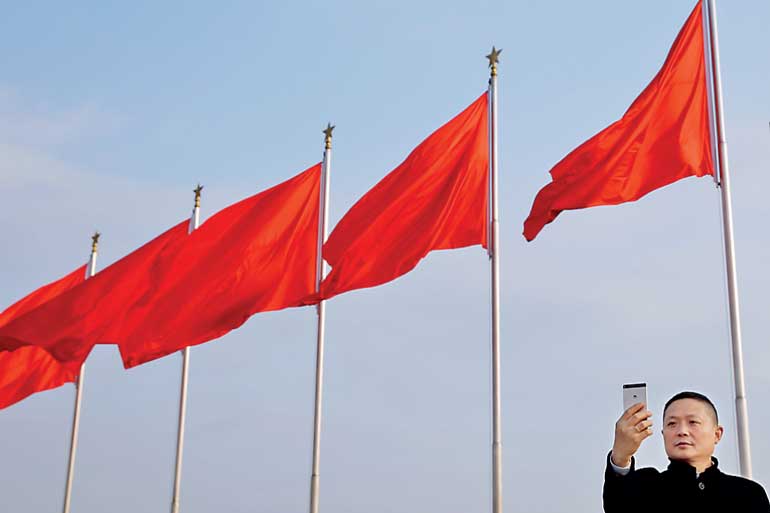Saturday Dec 20, 2025
Saturday Dec 20, 2025
Monday, 23 October 2017 00:00 - - {{hitsCtrl.values.hits}}
People’s Daily: China’s gross domestic product (GDP) expanded 6.9% year on year in the first three quarters of 2017 to 59.33 trillion yuan ($8.96 trillion), official data revealed on Thursday. The growth rate held steady from a 6.9percent increase in the first half of this year.

A man takes pictures on Tiananmen Square as the capital hosts the 19th National Congress of the Communist Party of China, in Beijing, China October 22, 2017 - REUTERS
In the third quarter, China’s GDP was up 6.8% year on year, compared with6.9 in the second quarter, according to the data released by the National Bureau of Statistics (NBS).
“This is the ninth straight quarter for China to see growth of 6.7 to 6.9%,” NBS spokesman Xing Zhihong told a press conference.
Production and consumption maintained a steady growth in the period. China’s value-added industrial output expanded 6.7% compared with the same period of last year, while retail sales of consumer goods grew 10.4% year on year to 26.32 trillion yuan.
Consumption maintained its position as the largest driver to Chinese economy, as the contribution of final consumption to economic growth reached 64.5% in the first nine months.
Employment improved significantly in the first three quarters: A total 10.97 million new jobs were created in urban China, 300,000 more than those of the same period last year.
The registered urban unemployment rate in 31 big cities has been kept below 5% for seven consecutive months. The figure for September was 4.83%, the lowest since 2012.
China maintained rapid growth in imports, exports and the surplus of its current account. With a steady RMB exchange rate, the foreign exchange reserve increased eight months in a row.
In the first three quarters, China’s added value in the service sector grew 7.8% compared with a year ago and the service industry contributed 58.8% to economic growth.
The added value of high-tech and equipment manufacturing respectively contributed more than 12% and 32% to the entire industrial output.. New economic vitality and potential represented by new technology, industry and business modes continued to be unleashed. In the first nine months, the year-on-year growth in output of strategic emerging industries rose to 11.3%, 4.6%age points higher than that of enterprises above a designated size. In the same period, the exponential growth of information and business services reached 29.4% and 11.4% respectively, while civilian drone production doubled against that of the same period last year.
The output of industrial robots grew 69.4% and new energy vehicles 30.8% compared with last year. Year-on-year growth of integrated circuit and solar energy batteries both exceeded 20%.
In the first nine months, online retail sales of physical commodities maintained a strong momentum with year-on-year growth of 29.1%, or 14% of the country’s total retail sales.
BEIJING (Reuters):China’s unemployment rate has hit its lowest point in multiple years at 3.95% by the end of September, but employment still face challenges as the economy pushes ahead with structural reforms, China’s labor ministry said on Sunday.
The ministry of human resources and social security said in a statement that 10.97 million new jobs had been created in China from January to September this year, a growth of 300,000 compared with the previous year.
The figure represents having essentially fulfilled the ministry’s year-end target, the ministry said in a pre-prepared statement given to reporters.
Despite being ahead of schedule, Yin Weimin, head of the ministry, told reporters that “raising the capacity to employ workers overall still faces large pressures.”
“We need to create 15 million jobs per year,” Yin said, singling out China’s more than 8 million new university graduates that enter the job market each year as one group in need of additional employment.
Yin also said the low unemployment rate in the face of an overall slowdown in the economy was largely due to the new internet economy and entrepreneurship, adding that the ministry would actively support startups to help them “thrive”. From 2015 to 2020 every one% increase in GDP is expected to equal roughly 1.8 million new jobs, Yin said.
Premier Li Keqiang said in March that China added 13.14 million new urban jobs in 2016 and aims to add another 11 million this year while keeping the registered unemployment rate below 4.5%.
The labor ministry’s announcement was made as part of a once-ever-five-years congress of the ruling Communist Party, which opened last Wednesday and runs until Tuesday.
At the congress, the Party sets broad policy directions and reshuffles top leaders. As China’s economy slows, Beijing has made increasing efforts to stave off mass unemployment that may spark social unrest. China’s official unemployment rate has remained generally stable as economic growth has dipped to a 26-year low and the government forges ahead with ambitious plans to cut back on industrial capacity.
Many analysts say, however, that the government figure is an unreliable indicator of national employment conditions as it measures only employment in urban areas and also doesn’t take into account the millions of migrant workers that form the bedrock of China’s labor force.
On an annual basis, the official unemployment rate was last below 4% in 2001, when it was 3.6%, according to data from the National Bureau of Statistics. The rate ended 2016 at 4.02% after not budging from 4.1% from 2010-2015.
The government has said that some sectors, especially those targeted by capacity cuts, such as coal and steel, still show signs of unresolved employment challenges.
The ministry of human resources in April said that China would need to resettle about half a million workers that lose jobs in the coal and steel sectors this year and will speed up development of a “black list” system for firms with wage arrears.